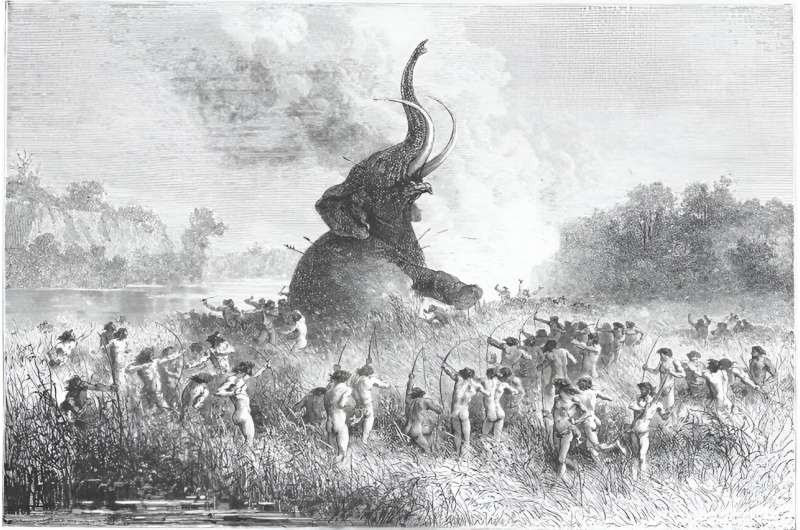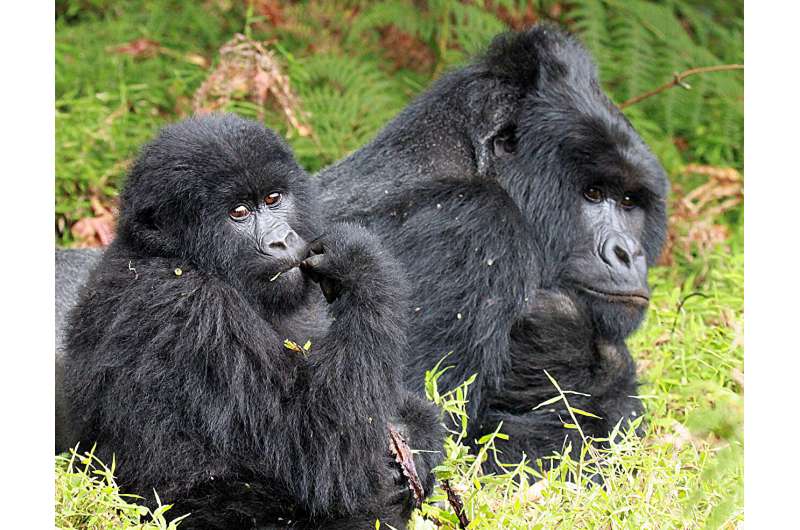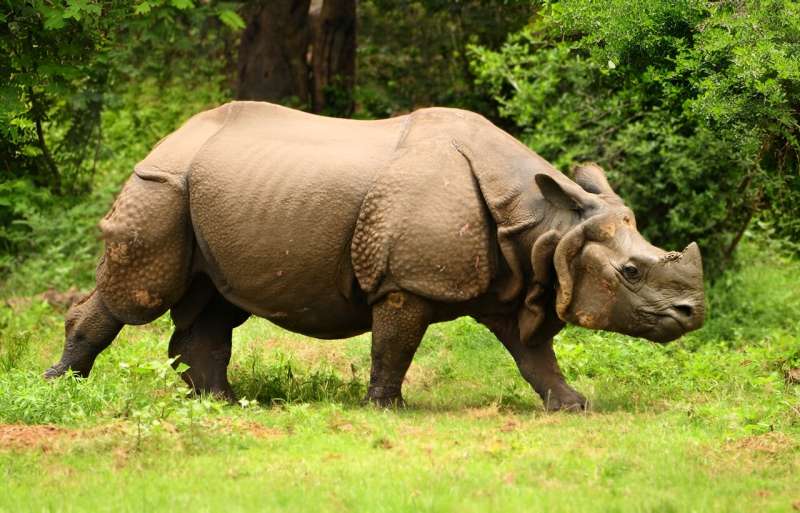This article has been reviewed according to Science X's editorial process and policies. Editors have highlighted the following attributes while ensuring the content's credibility:
fact-checked
peer-reviewed publication
trusted source
proofread
People, not the climate, found to have caused the decline of the giant mammals

For years, scientists have debated whether humans or the climate have caused the population of large mammals to decline dramatically over the past several thousand years. A new study from Aarhus University confirms that climate cannot be the explanation.
About 100,000 years ago, the first modern humans migrated out of Africa in large numbers. They were eminent at adapting to new habitats, and they settled in virtually every kind of landscape—from deserts to jungles to the icy taiga in the far north.
Part of the success was human's ability to hunt large animals. With clever hunting techniques and specially built weapons, they perfected the art of killing even the most dangerous mammals.
But unfortunately, the great success of our ancestors came at the expense of the other large mammals.
It is well-known that numerous large species went extinct during the time of worldwide colonization by modern humans. Now, new research from Aarhus University reveals that those large mammals that survived also experienced a dramatic decline.
By studying the DNA of 139 living species of large mammals, scientists have been able to show that the abundances of almost all species fell dramatically about 50,000 years ago.
This is according to Jens-Christian Svenning, a professor and head of the Danish National Research Foundation's Center for Ecological Dynamics in a Novel Biosphere (ECONOVO) at Aarhus University and the initiator of the study.
"We've studied the evolution of large mammalian populations over the past 750,000 years. For the first 700,000 years, the populations were fairly stable, but 50,000 years ago, the curve broke, and populations fell dramatically and never recovered," he says, and continues:
"For the past 800,000 years, the globe has fluctuated between ice ages and interglacial periods about every 100,000 years. If the climate was the cause, we should see greater fluctuations when the climate changed prior to 50.000 years ago. But we don't. Humans are, therefore, the most likely explanation."
Who killed the large mammals?
For decades, scientists have debated what is behind the extinction or rapid decline of large mammals over the past 50,000 years.
On one side are scientists who believe that rapid and severe fluctuations in the climate are the main explanation. For example, they believe that the woolly mammoth went extinct because the cold mammoth steppe largely disappeared.
On the opposite side are a group who believe that the prevalence of modern humans (Homo sapiens) is the explanation. They believe that our ancestors hunted the animals to such an extent that they either became completely extinct or were severely decimated.
So far, some of the most important evidence in the debate has been fossils from the past 50,000 years. They show that the strong, selective extinction of large animals in time and space roughly matches the spread of modern humans around the globe. Therefore, the extinction of animals can hardly be linked to climate. Nevertheless, the debate continues.
The new study presents brand new data that sheds new light on the debate. By looking at the DNA of 139 large living mammals—species that have survived for the past 50,000 years without becoming extinct—the researchers can show that the populations of these animals have also declined over the period. This development seems to be linked to the spread of humans and not climate change.

DNA contains the long-term history of the species
In the past 20 years, there has been a revolution within DNA sequencing. Mapping entire genomes has become both easy and inexpensive, and as a result, the DNA of many species has now been mapped.
The mapped genomes of species all over the globe are freely accessible on the internet—and this is the data that the research group from Aarhus University has utilized, explains Assistant Professor Juraj Bergman, the lead researcher behind the new study.
"We've collected data from 139 large living mammals and analyzed the enormous amount of data. There are approximately 3 billion data points from each species, so it took a long time and a lot of computing power," he says and continues:
"DNA contains a lot of information about the past. Most people know the tree of life, which shows where the different species developed and what common ancestors they have. We've done the same with mutations in the DNA. By grouping the mutations and building a family tree, we can estimate the size of the population of a specific species over time.", and antelopes,
The larger the population of an animal, the more mutations will occur. It's really a question of simple mathematics. Take elephants, for example. Every time an elephant is conceived, there's a chance that a number of mutations will occur, and it will pass these on to subsequent generations. More births means more mutations."
The large mammals
The 139 large mammals examined in the study are all species that exist today. They include elephants, bears, kangaroos and antelopes among others.
It is estimated that there are 6,399 species of mammals on the Earth, but the 139 extant megafauna were selected in this study to test how their populations changed over the past 40,000 to 50,000 years when similar large animals went extinct.
The large mammals are also called megafauna—and are defined as animals weighing more than 44 kg when fully grown. Humans are, therefore, also considered megafauna. In the study, however, the researchers examined species weighing as little as 22 kg so that all continents have been represented—except Antarctica.
Looking at the neutral parts of the DNA
However, the size of the elephant population is not the only thing that affects the number of mutations.
If the area in which elephants live suddenly dries up, the animals come under pressure—and this affects the composition of mutations. The same applies if two isolated groups of elephants suddenly meet and mix genes.

If not only the size of the population affects how many mutations occur, you would think that the results are rather uncertain. But this is not the case, explains Juraj Bergman.
"Only 10 percent of mammalian genomes consist of active genes. Great selection pressure from the environment or migration will primarily lead to mutations in the genes. The remaining 90 percent, on the other hand, are more neutral," he says and continues:
"We have therefore examined mutations in those parts of the genome that are least susceptible to the environment. These parts primarily indicate something about the size of the population over time."
The woolly mammoth is an atypical case
Much of the debate about what caused the large animals to either become extinct or decline has centered around the woolly mammoth. But this is a bad example because the majority of the megafauna species that went were associated with temperate or tropical climates, as Jens-Christian Svenning explains.
"The classic arguments for the climate as an explanatory model are based on the fact that the woolly mammoth and a number of other species associated with the so-called "mammoth steppe" disappeared when the ice melted, and the habitat type disappeared," he says, and continues, "This is basically an unsatisfactory explanatory model, as the vast majority of the extinct megafauna species of the period did not live at all on the mammoth steppe."
"They lived in warm regions, such as temperate and tropical forests or savannahs. In our study, we also show a sharp decline during this period in populations of the many megafauna species that survived and come from all sorts of different regions and habitats."
The final full stop in the debate has probably yet to be set, but Jens-Christian Svenning finds it difficult to see how the arguments for the climate as an explanation can continue.
"It seems inconceivable that it is possible to come up with a climate model that explains how, across all continents and groups of large animals, there have been extinctions and continuous decline since about 50,000 years ago. And how this selective loss of megafauna has been unique for the past 66 million years despite huge climate change."
"Given the rich data we now have, it's also hard to deny that instead, it is because humans spread across the globe from Africa and subsequently grew in population."
The findings are published in the journal Nature Communications.
More information: Juraj Bergman et al, Worldwide Late Pleistocene and Early Holocene population declines in extant megafauna are associated with Homo sapiens expansion rather than climate change, Nature Communications (2023). DOI: 10.1038/s41467-023-43426-5
Journal information: Nature Communications
Provided by Aarhus University




















